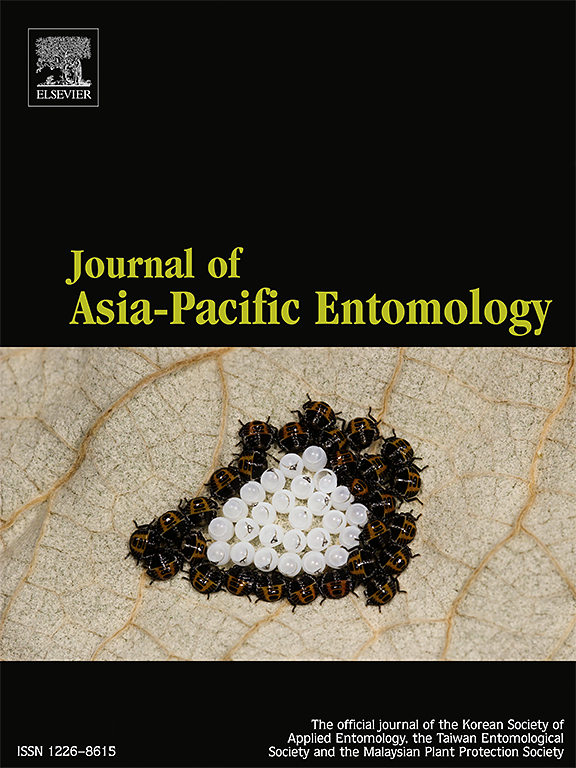高浓度氟苯尼考诱导家蚕中肠细胞凋亡的机制(鳞翅目:家蚕科)
IF 1.3
3区 农林科学
Q3 ENTOMOLOGY
引用次数: 0
摘要
家蚕(Bombyx mori)是鳞翅目模式昆虫,高浓度FF可损害中肠生理功能,但其作用机制尚不清楚。本研究通过家蚕连续暴露于高浓度(1.2 g/L) FF 72 h来研究其作用机制。结果表明,FF暴露显著抑制了中肠关键抗氧化酶SOD、CAT和TPX的活性。透射电镜显示,FF暴露后,细胞损伤明显,包括微绒毛脱落、染色质聚集、核膜凹陷、双膜结合囊泡自噬体、线粒体膜破裂和中肠肿胀。此外,治疗组中肠氧化磷酸化通路被明显抑制,线粒体BmCytochrome c的释放明显增加。BmCaspase-3和cleaved BmCaspase-3蛋白表达水平分别显著上调2.35倍和1.33倍,提示凋亡信号通路激活。此外,TUNEL染色证实FF诱导的中肠细胞凋亡信号增加。上述结果提示,高浓度FF暴露通过活性氧(ROS)积累引发家蚕中肠细胞凋亡,这是家蚕中肠生理功能障碍的机制。研究结果为评价高浓度FF暴露于非靶生物的安全性提供了参考。本文章由计算机程序翻译,如有差异,请以英文原文为准。

The mechanism of high-concentration florfenicol exposure inducing apoptosis in the midgut of Bombyx mori (Lepidoptera: Bombycidae)
The silkworm (Bombyx mori) is a Lepidoptera model insect, high concentrations of FF can impair the midgut physiological function, but the mechanism of action of which is still unclear. In this study, silkworms were continuously exposed to high concentrations (1.2 g/L) of FF for 72 h to investigate its mechanism of action. The results showed that FF exposure significantly inhibited the activity of key antioxidant enzymes, SOD, CAT, and TPX, in the midgut. Transmission electron microscopy revealed notable cellular damage, including microvilli shedding, chromatin aggregation, nuclear membrane depression, double membrane-bound vesicle autophagosomes, mitochondrial membrane rupture and swelling in the midgut after FF exposure. Furthermore, the oxidative phosphorylation pathway in the midgut was markedly suppressed, and the release of mitochondrial BmCytochrome c was significantly increased in the treatment group. The protein expression levels of BmCaspase-3 and cleaved BmCaspase-3 significantly were upregulated by 2.35-fold and 1.33-fold respectively, indicating the activation of the apoptotic signaling pathway. Additionally, TUNEL staining confirmed increased apoptotic signals in the midgut induced by FF. These findings suggest that high-concentration FF exposure triggers midgut apoptosis by reactive oxygen species (ROS) accumulation, which is the mechanism of physiological dysfunction in the midgut of silkworms. The research results provide a reference for evaluating the safety of high-concentration FF exposure in non-target organisms.
求助全文
通过发布文献求助,成功后即可免费获取论文全文。
去求助
来源期刊

Journal of Asia-pacific Entomology
Agricultural and Biological Sciences-Insect Science
CiteScore
2.70
自引率
6.70%
发文量
152
审稿时长
69 days
期刊介绍:
The journal publishes original research papers, review articles and short communications in the basic and applied area concerning insects, mites or other arthropods and nematodes of economic importance in agriculture, forestry, industry, human and animal health, and natural resource and environment management, and is the official journal of the Korean Society of Applied Entomology and the Taiwan Entomological Society.
 求助内容:
求助内容: 应助结果提醒方式:
应助结果提醒方式:


